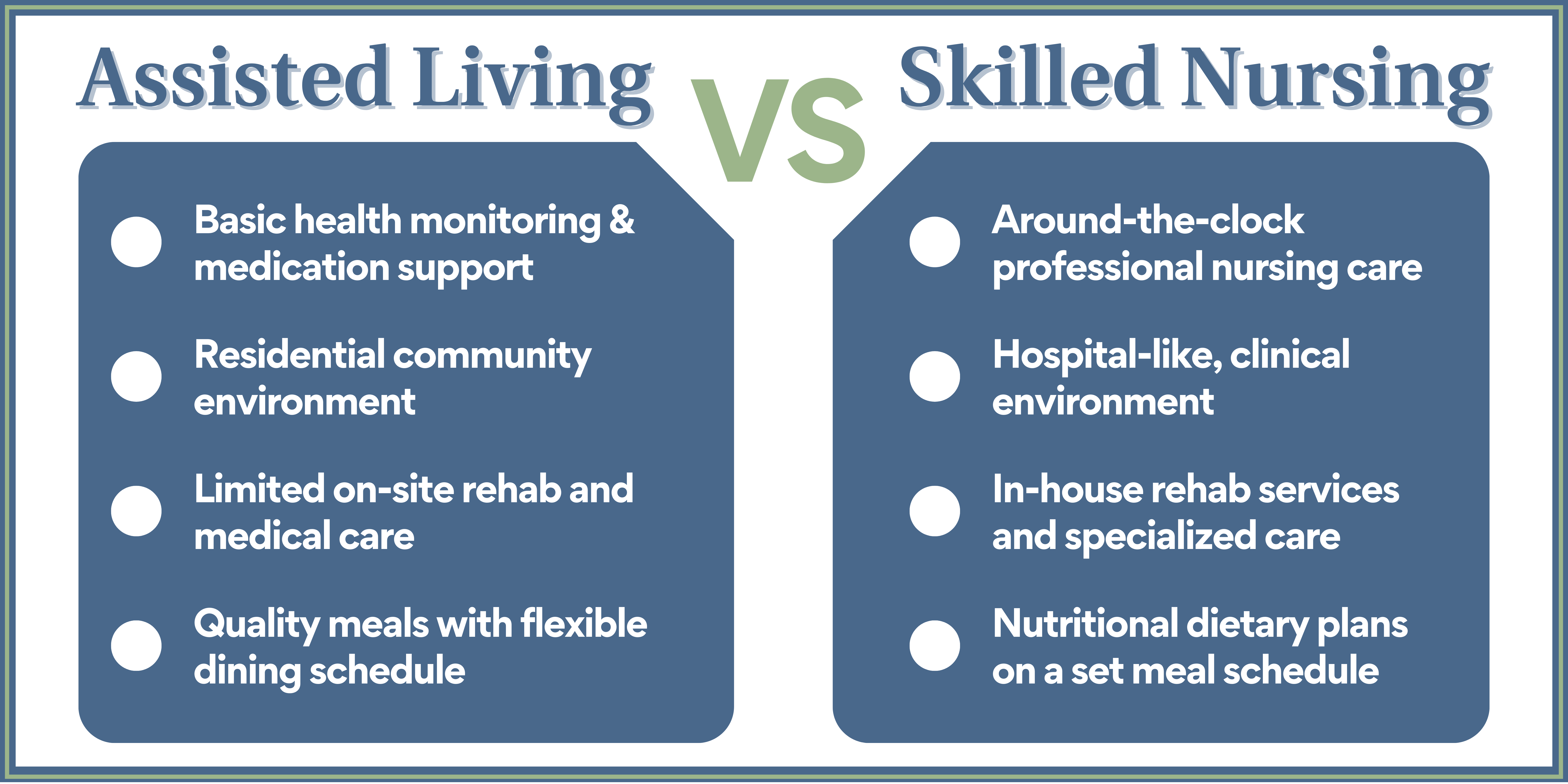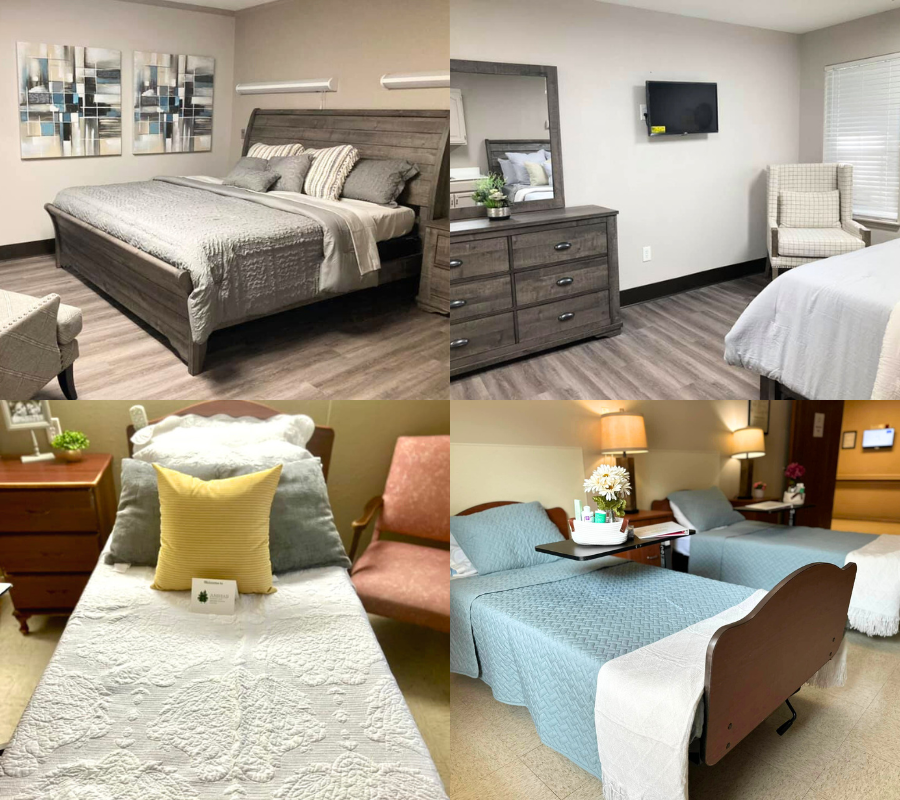Assisted Living Vs. Skilled Nursing
Understanding the Difference

When seeking care for themselves or their loved ones, many families and individuals are faced with the challenging decision of choosing between Assisted Living and Skilled Nursing facilities. Both types of facilities offer valuable services, but they cater to different levels of care and have very distinct features.
By gaining a deeper understanding of these two options, you will be better equipped to make an informed choice that aligns with the specific needs and preferences of your loved one. Whether you are at the beginning of this journey or considering a transition from one level of care to another, our goal is to answer your questions and provide you with what you need to make the most informed decision.
Assisted Living
Assisted Living typically caters to individuals who require assistance but do not need the intense medical care provided in Skilled Nursing facilities. It’s an option for seniors who would like to maintain their independence while also benefiting from the support structure Assisted Living provides.
These communities offer a variety of services designed to enhance the quality of life for their residents. This type of care serves to assist residents with their activities of daily living (ADLs). These activities include bathing, dressing, grooming, and mobility, among others. Residents in Assisted Living communities can expect help with these tasks, while ensuring they can maintain a comfortable and independent lifestyle.
Assisted Living facilities provide an environment similar to residential communities and offer entertainment, meal preparation, a wide range of social activities, and medical assistance as needed.
Skilled Nursing
Skilled Nursing facilities provide a higher level of medical care and support for seniors with complex medical needs. These facilities are staffed with registered nurses, certified nursing aides, and other medical staff, who are trained to deliver specialized care.
Residents in Skilled Nursing facilities often have chronic health conditions, disabilities, or post-surgery recovery needs that require regular medical attention. Skilled Nursing staff can give medications, manage wounds, and provide around-the-clock care to ensure residents’ health and safety.
Another service of Skilled Nursing is rehabilitation therapy. Residents who need physical, occupational, or speech therapy can access specialized rehab services within these facilities. This is especially valuable for seniors recovering from surgeries or serious injuries, as they can receive specialized therapies to regain their mobility.
In Skilled Nursing facilities, residents have immediate access to medical professionals, making it an appropriate choice for individuals with more complex health needs.
Differences Between ALFs and SNFs
Assisted Living and Skilled Nursing facilities differ in many ways including services provided, overall structure, cost, etc. It is important to note these key differences when deciding what type of care best meets your needs.

Medication and Medical Support
One of the biggest differences between Assisted Living and Skilled Nursing is the level of medical care provided within the facility. While Assisted Living facilities do provide some medical services, they are generally limited in scope. These medical services typically include basic healthcare monitoring like checking vital signs, blood pressure and providing medication support. These communities typically will have nurses on call for basic healthcare needs, but residents may seek outside care from their doctors, physicians, occupational therapists, etc.
Skilled Nursing offers a higher level of medical care, including around the clock professional nursing care, medication management, and in-house specialized therapies. Residents in these facilities typically have higher medical dependencies, such as chronic medical conditions, post-surgery recovery needs, neurological diseases, ventilator needs, or cognitive impairments. These require residents to need immediate access to medical professionals, and physical, speech, and occupational therapies.
Nutrition and Meal Preparation
The Assisted Living dietary approach often focuses on providing balanced and nutritious meals in a communal dining setting. Residents have the flexibility to choose their mealtimes and can enjoy socializing with their peers during shared meals. The emphasis is on promoting independence and a homely dining experience.
Skilled Nursing facilities adhere to more structured dietary and meal plans. Breakfast, lunch, and dinner are typically provided on a specific schedule to ensure residents receive necessary nutrition and medications at the right time. Additionally, dietary plans in Skilled Nursing may be more specialized, addressing specific medical needs and dietary restrictions, with close monitoring by healthcare professionals.

Structure and Routine
Assisted Living facilities are similar to residential communities in that they allow the residents to have more autonomy and independence. There is a structure in place to enhance the quality of life, including meal preparation, planned activities, and group outings, but overall, the residents are able to make choices about their daily routines.
Skilled Nursing may follow a more structured daily routine. Because of the higher level of medical dependence in these facilities, residents receive scheduled medical care, including medication administration, wound care, and therapy sessions. There is also more structure surrounding things like mealtimes and planned activities.
Cost and Finances
There are many ways costs can vary within these facilities depending on factors like insurance, benefits, licensing, etc. Because of the higher level of care offered, Skilled Nursing is often more expensive. Depending on eligibility, some residents may have expenses covered by Medicaid or Medicare. Assisted Living can be more affordable , but can vary based on care needs, location, and the providers cost structure. Although these expenses are often considered out-of-pocket, there are also payment plans and options to cover the cost of living.
Setting and Environment

The overall environment is another key difference. Assisted Living is more often geared towards long-term stays and is set up more similarly to a residential community. Residents have more privacy in “apartment-like” rooms. Amenities can vary depending on the community, but these types of rooms are often equipped with kitchenettes and other living spaces. There may also be common areas such as fitness centers, dining areas, activity rooms, etc.
Skilled Nursing facilities have a more clinical environment. They are equipped to provide intensive medical care and rehabilitation services. The room layout is often more hospital-like. Similar to dorm-style living, residents may have private rooms or share rooms with one or more individuals . Residents in shared rooms are still entitled to their privacy and their own personal space. There are common areas for resident gatherings such as dining and therapy rooms, and there are also centrally located nurses’ stations through the facility.
Similarities
Although there are key differences between Assisted Living and Skilled Nursing, there are also things that you can rely on at both levels of care. Both types of facilities prioritize the safety and wellness of residents by following health and security regulations, having set emergency protocols, and valuing the cleanliness of the facility.
ALFs and SNFs also both aim to enhance the residents’ quality of life by having opportunities for residents to engage with their community and peers. They can experience planned activities, community outings, organized holiday events, etc.
These similarities highlight the commitment of both Assisted Living and Skilled Nursing to provide high-quality care and a supportive environment. However, it’s important to consider the differences between them to make an informed decision about which option will best meet the unique needs of you or your loved one.
Making a Choice
The choice between Assisted Living and Skilled Nursing is an important decision that should be made based on individual needs, preferences, and healthcare requirements. Assisted Living offers a supportive environment for seniors seeking a balance between independence and assistance with daily tasks, while Skilled Nursing provides intensive medical care and rehabilitation for those with complex health needs.
Knowing the differences between these two levels of care will allow you to make a more informed choice about which one will better meet you or your loved one’s care needs.
Creative Care Options
At Creative Solutions in Healthcare, we offer a unique approach to senior care. Our facilities provide a more intimate and close-knit community for our residents, where health, nutrition, and happiness are prioritized. What sets us apart is our transparent cost structure. While other providers may add additional charges for amenities and services, we offer a flat, all-inclusive price, ensuring a more hassle-free billing experience. We also provide transportation, so residents never have to worry about getting to their appointments.
Creative Solutions in Healthcare has options for you and your loved one across each stage of the care journey. To learn more about the types of care our facilities offer, or to locate an Assisted Living or Skilled Nursing facility near you, visit our facility locator.
